What is Supply Planning

Supply planning is an essential component in the logistics and operations management of a business. It involves the strategic process of quantifying future demand and planning how to fulfill it. This may include managing inventory levels, coordinating with suppliers, and setting production plans. The objective of supply planning is to balance the supply and demand, minimizing stockouts and overstocks while optimizing costs and efficiency.
Defining Supply Planning: Supply planning is a business procedure that aims to meet the organization’s demand by efficiently managing and planning the supply-side activities. It involves predicting the amount of product a business needs to fulfill its future demand, determining resources necessary to make that product, and planning the logistics associated with acquiring and delivering the product to consumers. Supply planning can cover various aspects from inventory management, sourcing, production planning, demand forecasting, and logistics.
Supply planning is more than just an inventory control process; it’s a strategic approach to maximize customer satisfaction, minimize inventory costs, and optimize resource utilization.
Supply planning is a crucial element in the spectrum of supply chain management. It involves the tactical planning and orchestration of all activities to meet the demand for goods and services. In essence, it’s a systematic approach to balance demand and supply, ensuring resources are used efficiently to deliver products or services to consumers.
The Importance of Supply Planning
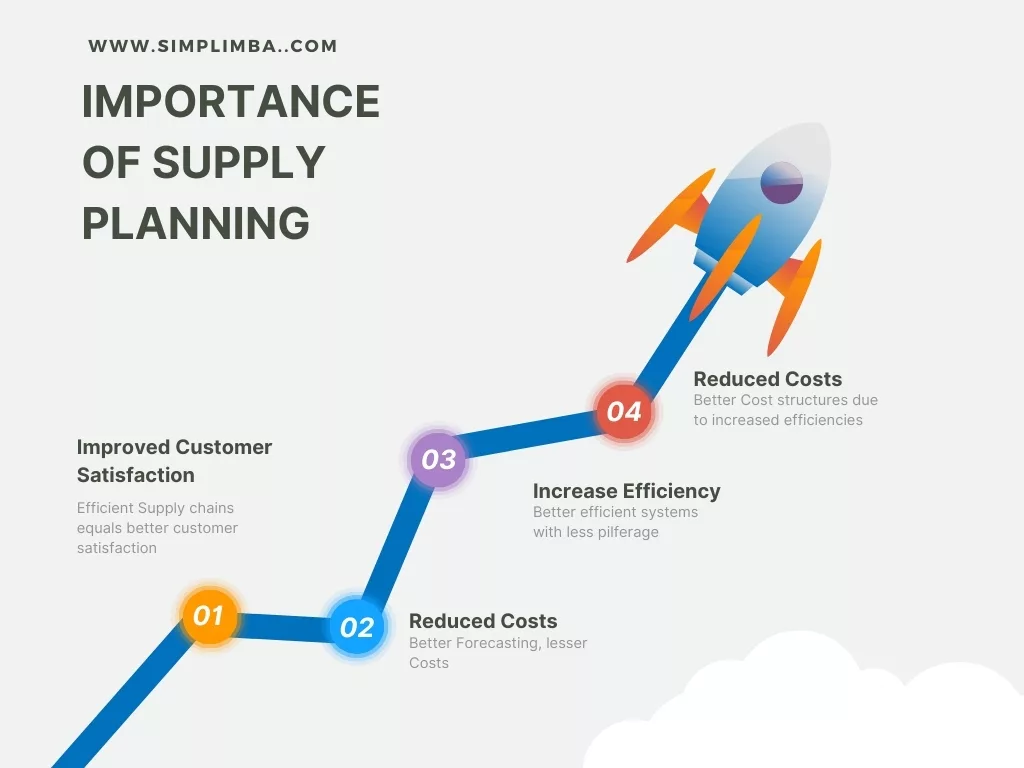
Improved Customer Satisfaction: With efficient supply planning, businesses can ensure they always have the right products available when customers want them, leading to higher customer satisfaction and loyalty.
Reduced Costs: By accurately forecasting demand and planning supply, companies can avoid overproduction and excess inventory, both of which tie up capital and create storage costs.
Increased Efficiency: Effective supply planning can streamline operations, reduce lead times, and increase the overall efficiency of the supply chain.
Risk Management: Supply planning allows businesses to anticipate and mitigate risks such as supplier failures, unexpected demand spikes, or disruptions in the supply chain.
Evolution of Supply Planning
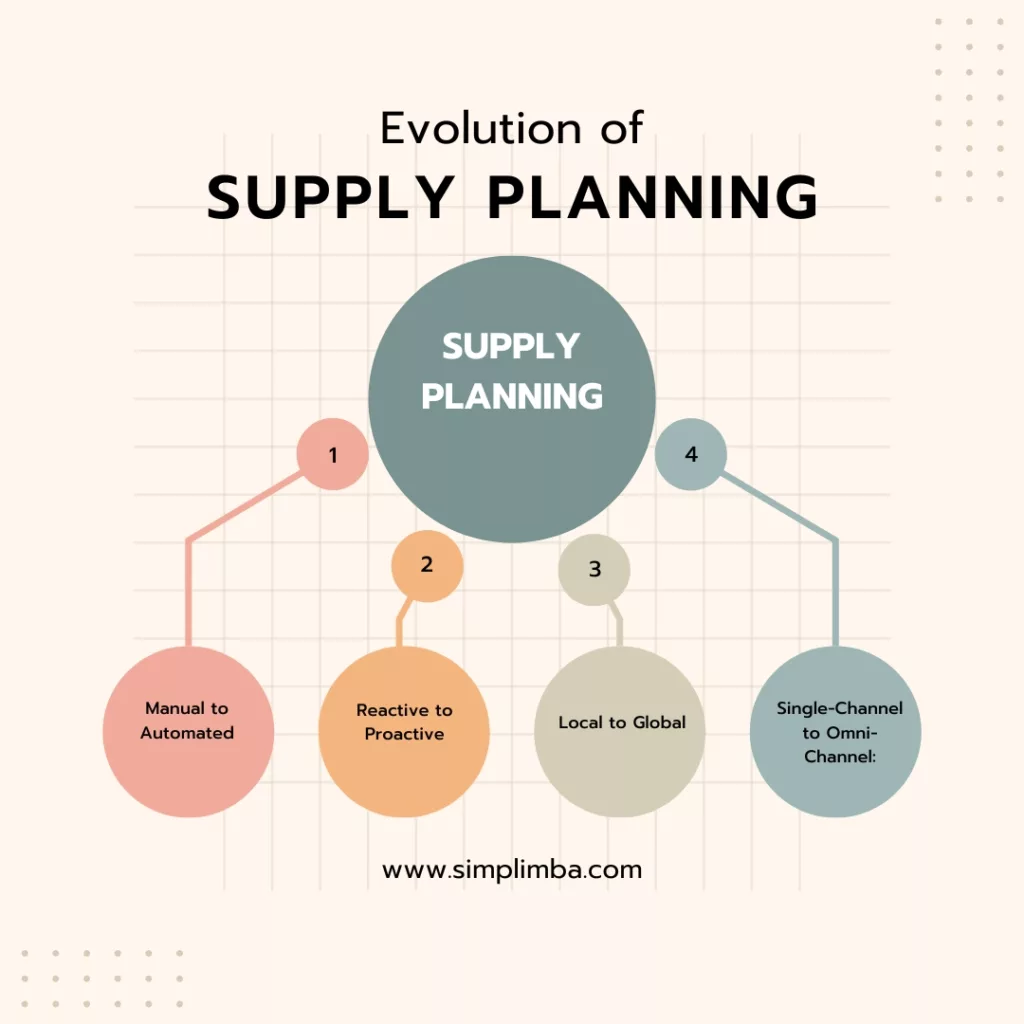
Over time, supply planning has evolved significantly with advancements in technology and changes in market dynamics.
Manual to Automated: In the past, supply planning was often a manual process involving spreadsheets. Today, most businesses use sophisticated supply planning software that can automatically analyze data, forecast demand, and generate supply plans.
Reactive to Proactive: Earlier, supply planning was mostly reactive, responding to demand after it occurred. Now, it’s increasingly proactive, using predictive analytics to anticipate demand and plan supply in advance.
Local to Global: As businesses have expanded globally, supply planning has had to evolve to manage more complex, international supply chains.
Single-Channel to Omni-Channel: With the rise of e-commerce and omni-channel retail, supply planning now has to account for demand and fulfillment across multiple channels.
As we can see, supply planning is a critical aspect of business operations that has evolved considerably over time and will continue to do so with further advancements in technology and shifts in the business landscape.
The Role of Supply Planning in Business
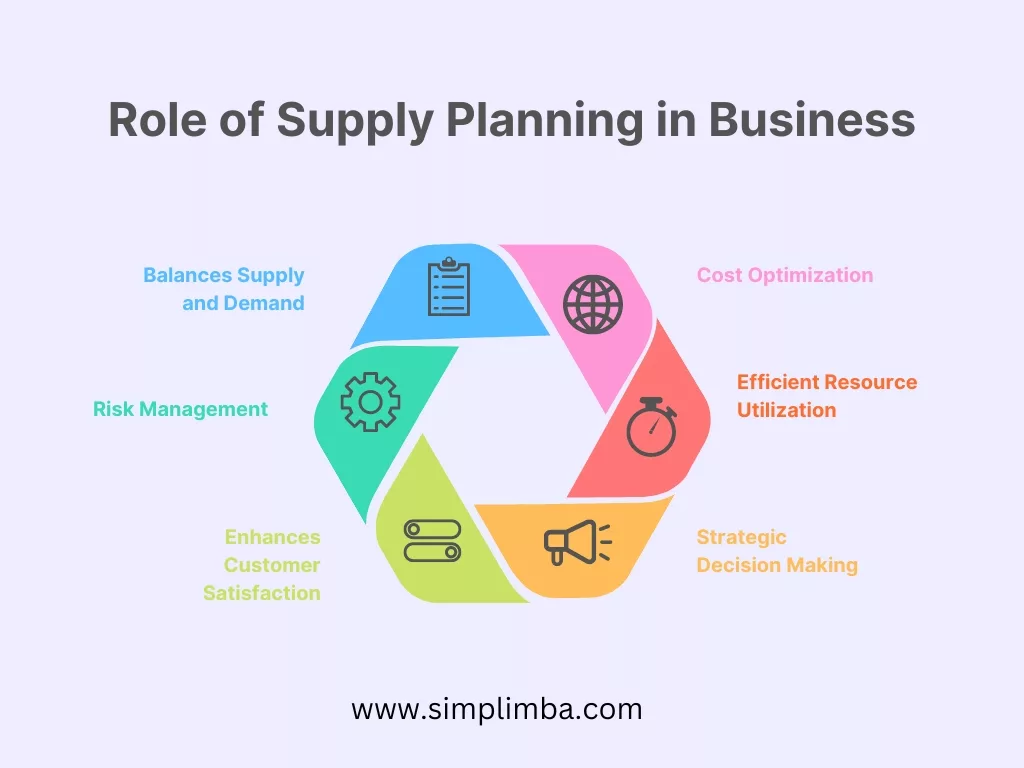
Balances Supply and Demand: A primary role of supply planning is to ensure that supply meets demand. This involves demand forecasting, where data is analyzed to predict future sales trends, and inventory management, where stock levels are monitored to prevent overstocking or understocking.
Efficient Resource Utilization: Supply planning helps in the optimal utilization of resources. By analyzing data on production capacity, manpower, and materials, the organization can ensure that resources are neither wasted nor underutilized.
Cost Optimization: Effective supply planning can reduce costs by minimizing inventory holding costs, reducing stockouts and overstocking situations, and improving the efficiency of supply chain operations.
Enhances Customer Satisfaction: Timely and efficient delivery of products is crucial for customer satisfaction. Through accurate demand forecasting and efficient logistics planning, supply planning ensures that customer demands are met promptly.
Risk Management: Supply planning also plays a vital role in risk management. It helps in identifying potential supply chain disruptions and devising contingency plans to handle such situations.
Strategic Decision Making: Supply planning also contributes to strategic decision-making. By providing insights into supply chain performance, it helps businesses make informed decisions about product launches, market expansion, mergers, and acquisitions.
Supply Planning Process Flow: A Detailed Overview
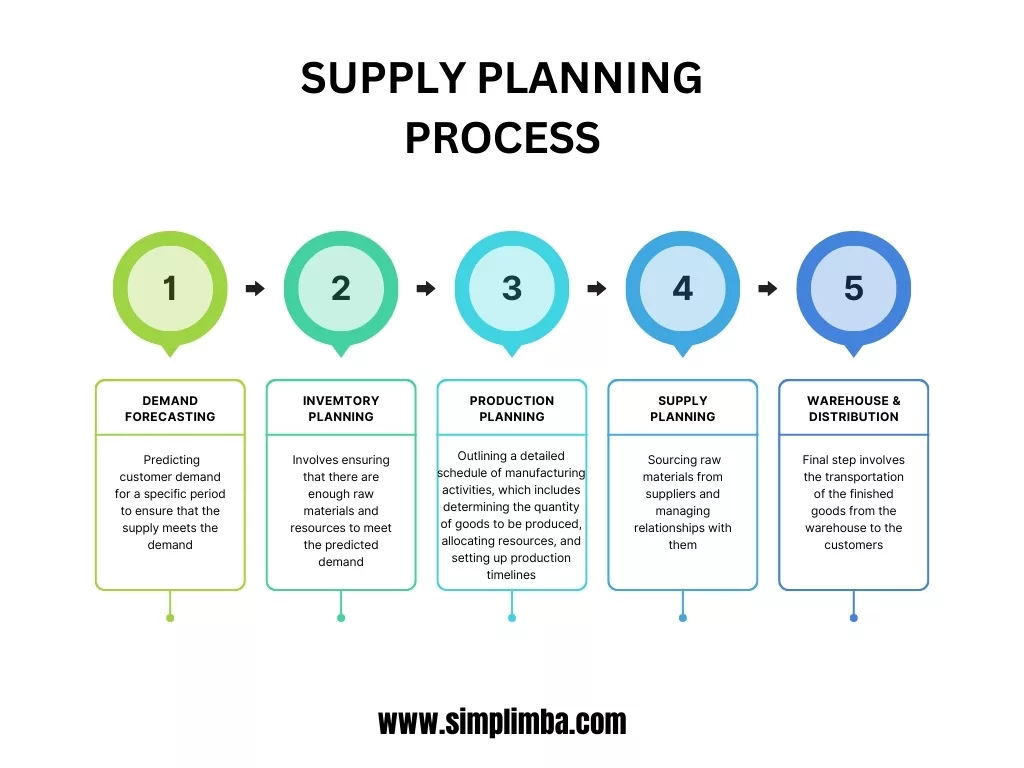
Demand Forecasting
This is the first and most crucial step in the supply planning process. It involves predicting customer demand for a specific period to ensure that the supply meets the demand. This step uses historical sales data, market trends, and other relevant factors to make accurate predictions. According to a report by Gartner, companies that excel in demand forecasting average 15% less inventory, 17% stronger perfect order fulfillment, and 35% shorter cash-to-cash cycle times.
Inventory Planning
Once demand is forecasted, the next step is to plan the inventory accordingly. This involves ensuring that there are enough raw materials and resources to meet the predicted demand. The overall goal is to minimize inventory costs while meeting customer needs. A study by McKinsey found that efficient inventory planning can lead to a 10%–40% reduction in working capital and operating costs.
Production Planning
Production planning involves outlining a detailed schedule of manufacturing activities, which includes determining the quantity of goods to be produced, allocating resources, and setting up production timelines. According to the American Production and Inventory Control Society (APICS), effective production planning can reduce production time by 12% and increase on-time delivery rates by 26%.
Supplier Management
This step involves sourcing raw materials from suppliers and managing relationships with them. It’s crucial to ensure suppliers can meet your demand requirements in terms of quantity and delivery time. According to a survey by Deloitte, 79% of organizations with superior supply chain capabilities achieve revenue growth greater than the average within their industries, credited in part to effective supplier management.
Warehouse Management
Warehouse management is about maintaining and controlling the day-to-day operations in a warehouse, such as inventory management, order fulfillment, and shipping. Efficient warehouse management can improve order accuracy, speed up order cycle times, and increase warehouse space utilization. According to a report by Zebra Technologies, 74% of respondents saw increased productivity due to improved warehouse management.
Distribution and Logistics
This final step involves the transportation of the finished goods from the warehouse to the customers. It requires careful planning and coordination to ensure timely and cost-effective delivery. According to a report by PwC, companies that prioritized advanced supply chain capabilities saw a 2-3 times improvement in supply chain cost efficiency and customer fulfillment metrics.
The 7 Powerful Strategies for Streamlining Your Supply Planning
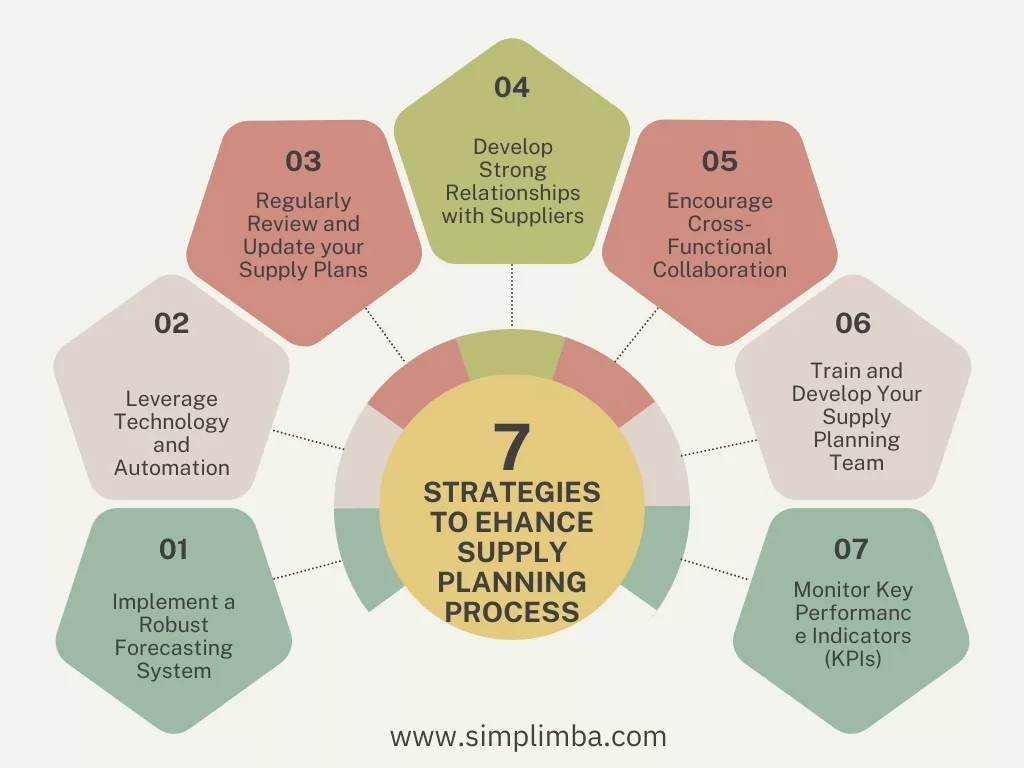
Strategy 1: Implement a Robust Forecasting System
The first step towards streamlining your supply planning is to implement a robust forecasting system. This includes using statistical models and advanced analytics to predict future demand accurately. According to the Institute of Business Forecasting & Planning, companies that excel in demand forecasting average 15% less inventory, 17% stronger perfect order fulfillment, and 35% shorter cash-to-cash cycle times.
Strategy 2: Leverage Technology and Automation
With the advent of Industry 4.0, businesses are increasingly leveraging technology and automation to enhance their supply chain efficiency. This includes utilizing intelligent software solutions, IoT devices, AI, and machine learning algorithms. A survey from McKinsey suggests that companies that aggressively digitize their supply chains can expect a boost in annual growth of earnings before interest and taxes by 3.2% – the largest increase from digitizing any business area.
Strategy 3: Regularly Review and Update your Supply Plans
Supply planning is not a one-time activity. It requires regular review and updates to align with the changing market dynamics, customer demands, and business objectives. A report from Gartner suggests that companies should review and update their supply plans at least once a quarter to maintain competitiveness.
Strategy 4: Develop Strong Relationships with Suppliers
In today’s interconnected and globalized world, having strong relationships with your suppliers is key to ensuring a smooth supply chain process. This includes clear communication, collaboration, and negotiation. According to the Harvard Business Review, companies with strong supplier relationships enjoy up to a 60% higher profit margin than competitors who don’t prioritize supplier relationships.
Strategy 5: Encourage Cross-Functional Collaboration
Supply planning is not solely the responsibility of the supply chain department. It requires cross-functional collaboration involving marketing, sales, finance, and operations. A study from APQC reveals that organizations with cross-functional teams can reduce supply chain planning cycle times by up to 75% and improve forecast accuracy by up to 20%.
Strategy 6: Train and Develop Your Supply Planning Team
A skilled and knowledgeable supply planning team is crucial to effectively implement and manage your supply planning strategies. This includes regular training and development programs to keep them up to date with the latest trends, technologies, and best practices. According to the American Production and Inventory Control Society, companies that invest in supply chain training and development have a 53% higher inventory turnover rate.
Strategy 7: Monitor Key Performance Indicators (KPIs)
Finally, it’s important to continuously monitor key performance indicators (KPIs) to assess the effectiveness of your supply planning strategies. This includes KPIs like order cycle time, fill rate, inventory turnover, and forecast accuracy. A survey from Aberdeen Group suggests that companies that utilize KPIs effectively reduce their operating costs by up to 23% and increase their profitability by up to 19%.
Case Studies: Successful Supply Planning in Action
Case Study 1: Optimizing Supply Planning in the Automotive Industry
The automotive industry is a prime example of successful supply planning. For instance, Toyota, the world’s second-largest automotive manufacturer, employs a Just-In-Time (JIT) supply chain management strategy, which allows them to minimize waste and increase efficiency.
Inventory Management: Toyota utilizes a JIT system to reduce inventory costs and improve efficiency. They only order materials when required for production, thus avoiding excess inventory and wastage. The company reported that through JIT, they managed to reduce the inventory handling costs by 45% in the year 2019.
Supplier Collaboration: Toyota maintains strong relationships with its suppliers, which is crucial for JIT to work. They share production schedules with their suppliers to ensure components are delivered exactly when needed. This collaboration has led to a 30% decrease in lead time.
Risk Management: Toyota undertakes potential risk assessments to prevent supply chain disruptions. When the 2011 earthquake and tsunami hit Japan, Toyota learned a hard lesson about the importance of diversifying its supply chain to minimize disruptions.
Automation: The use of artificial intelligence (AI) and machine learning (ML) to predict demand, manage inventory, and schedule production has reportedly increased Toyota’s supply chain efficiency by 25%.
Case Study 2: Streamlining Supply Planning in the Retail Industry
Walmart, a multinational retail corporation, has also benefited from effective supply planning.
Inventory Management: Walmart uses a cross-docking inventory system. Products are unloaded from suppliers and loaded directly onto outbound trucks. This practice reduces storage and inventory carrying costs. Walmart reported a 70% reduction in storage costs and a significant decrease in inventory levels in 2020 due to cross-docking.
Robust Technology: Walmart employs state-of-the-art technology for demand forecasting, inventory management, and replenishment. The introduction of machine learning and AI has improved demand forecasting accuracy by 20%.
Supplier Relationships: Like Toyota, Walmart values its supplier relationships. Their Supplier Alliance Program ensures that suppliers provide products at the right time, in the right quantities, and at the right price.
Sustainable Practices: Walmart aims to reduce its environmental impact through its supply chain. They have implemented a zero-waste policy and target to reduce greenhouse gas emissions in their supply chains by 18% by 2025.
Both Toyota and Walmart show that a well-planned supply chain can significantly enhance business performance. Their success is due to a combination of efficient inventory management, strong supplier relationships, technological advancements, and sustainable practices.
Common Challenges in Supply Planning and How to Overcome Them
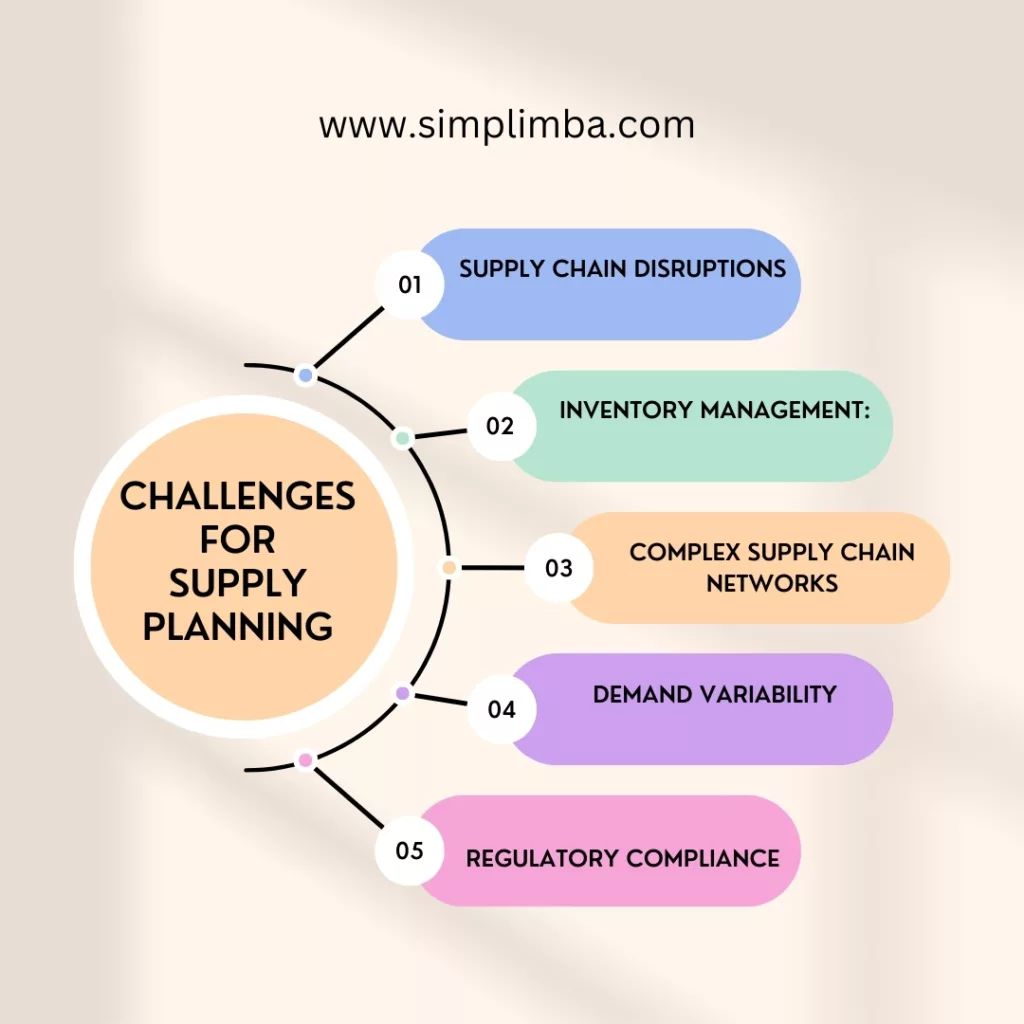
Demand variability: The primary challenge in supply planning is predicting demand. With consumers’ changing preferences and market trends, it’s difficult to anticipate demand accurately. Without the correct forecasts, businesses face overstock or supply shortages, both of which can be costly. Accurate demand forecasting requires analyzing historical sales data, understanding market trends, and considering other external factors like the economy, seasonality, and competitor activity, among others.
To overcome this, companies can employ advanced analytics tools and techniques that leverage machine learning and AI to improve forecast accuracy. These tools can analyze vast amounts of data, identify trends and patterns, and make more accurate predictions.
Supply chain disruptions: Natural disasters, political instability, trade wars, and pandemics can disrupt supply chains, causing delays and shortages. For instance, during the COVID-19 pandemic, 75% of businesses had their supply chain disrupted, according to a survey by the Institute for Supply Management.
To mitigate this, companies should have a robust risk management strategy in place, including diversifying suppliers, developing contingency plans, and investing in supply chain visibility technologies.
Inventory management: Balancing inventory levels to fulfill demand without overstocking is another common challenge. According to the National Retail Federation, US retailers lose $45 billion annually due to overstock and $45 billion from out-of-stock.
This could be overcome by implementing an effective inventory management system that uses real-time data to optimize stock levels. Also, employing a JIT (Just-In-Time) strategy can help reduce inventory costs and improve cash flow.
Complex supply chain networks: With globalization, supply chains have become increasingly complex, involving multiple parties across different geographies. This complexity makes coordination difficult and increases the risk of errors and delays.
To address this, companies can use supply chain management software that provides a centralized platform for communication and collaboration. Additionally, adopting a digital twin model can help visualize the entire supply chain, identify bottlenecks, and optimize processes.
Regulatory compliance: Regulations vary by country and industry, and non-compliance can lead to hefty fines and damaged reputation. For example, in 2019, the US Food and Drug Administration fined companies a total of $6.1 billion for regulatory violations.
To ensure compliance, companies should invest in compliance management systems and regularly train their staff on the latest regulations. Moreover, working closely with local partners can help navigate through complex regulatory landscapes.
Each of these challenges can be effectively managed with careful planning, investment in the right tools and technologies, and a proactive approach to risk management. By doing so, businesses can ensure a smooth and efficient supply chain that drives growth and profitability.
The Future of Supply Planning
Adoption of Advanced Technologies
Now more than ever, technologies such as Artificial Intelligence (AI) and Machine Learning (ML) are becoming integral to supply planning. A study by Gartner reveals that 37% of businesses have implemented AI in some form, a 270% increase over the past four years. As AI and ML continue to evolve, they are expected to play a more significant role in predicting demand, identifying supply chain disruptions in advance, and optimizing inventory levels.
Increased Use of Real-Time Data
Real-time data is becoming a game-changer in supply planning. According to IBM, 62% of retail supply chain executives report using real-time data to improve their supply chain operations. This trend will likely continue as businesses seek to reduce lead times, improve service levels, and make more informed, timely decisions.
Sustainability Initiatives
As climate change becomes an increasing concern, more companies are seeking to integrate sustainability into their supply planning. For instance, many businesses are aiming to reduce waste by improving their inventory forecasting accuracy or opting for more environmentally friendly transport methods. A recent study by Unilever shows that sustainable businesses are growing 69% faster than those not focused on sustainability.
Integration of Supply Planning with Other Business Operations
Integration between supply planning and other business functions like sales, marketing, and finance is becoming increasingly important. As per a report from McKinsey, companies that have integrated planning capabilities across their organization have seen up to a 20% increase in revenues.
Risk Management and Resilience Planning
The COVID-19 pandemic has highlighted the importance of risk management and resilience in supply planning. Companies are now investing more resources into predicting and preparing for potential disruptions. A survey by Deloitte revealed that 94% of Fortune 1000 companies experienced supply chain disruptions due to COVID-19, showing the necessity for robust risk management strategies.
Increased Outsourcing of Supply Planning Operations
Outsourcing of supply planning operations is another growing trend. It helps companies to focus on their core competencies while gaining access to experts in supply planning. Statista reports that the global outsourcing market reached $92.5 billion in 2019.
Rise of E-commerce and Direct-to-Consumer Models
E-commerce and direct-to-consumer models have revolutionized supply planning. As per a report by Statista, e-commerce sales are expected to reach $4.5 trillion by 2023, leading to changes in how products are stored, transported, and delivered.
This is a comprehensive view of the future of supply planning. As technology continues to evolve and business landscapes shift, supply planning will undoubtedly adapt to become more efficient, resilient, and sustainable
Samrat is a Delhi-based MBA from the Indian Institute of Management. He is a Strategy, AI, and Marketing Enthusiast and passionately writes about core and emerging topics in Management studies. Reach out to his LinkedIn for a discussion or follow his Quora Page

